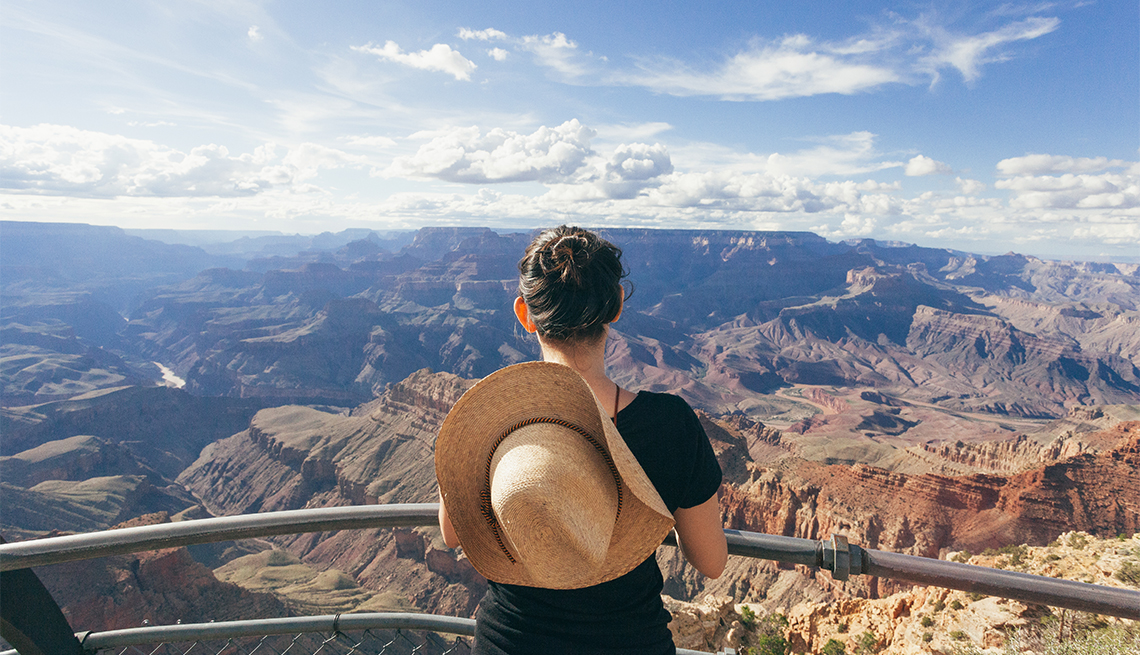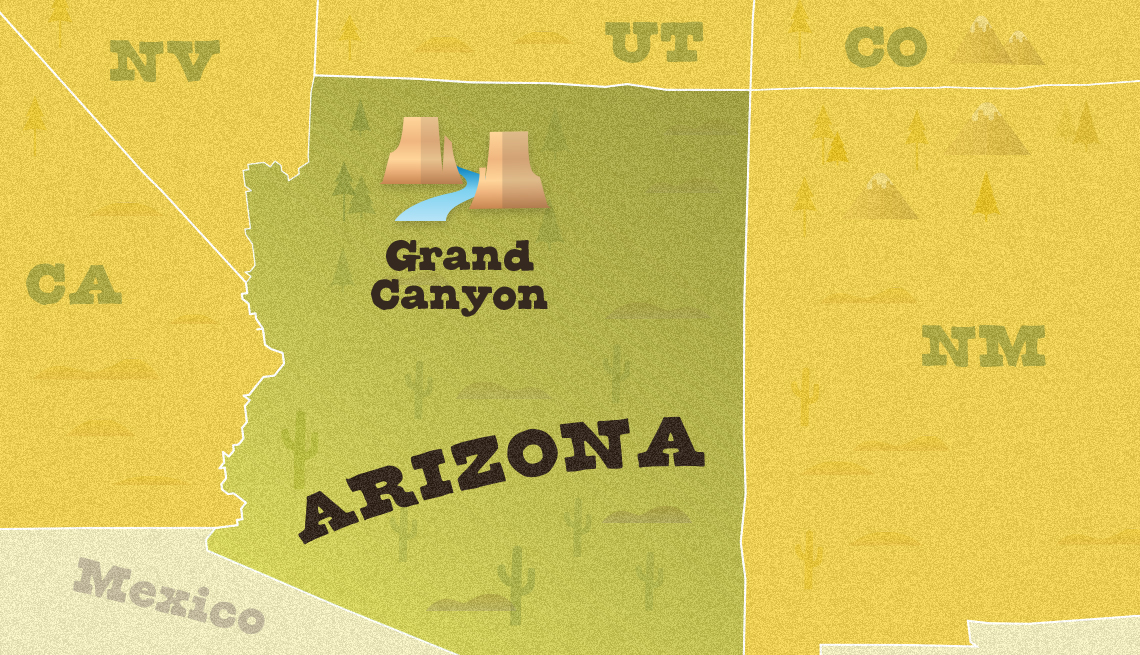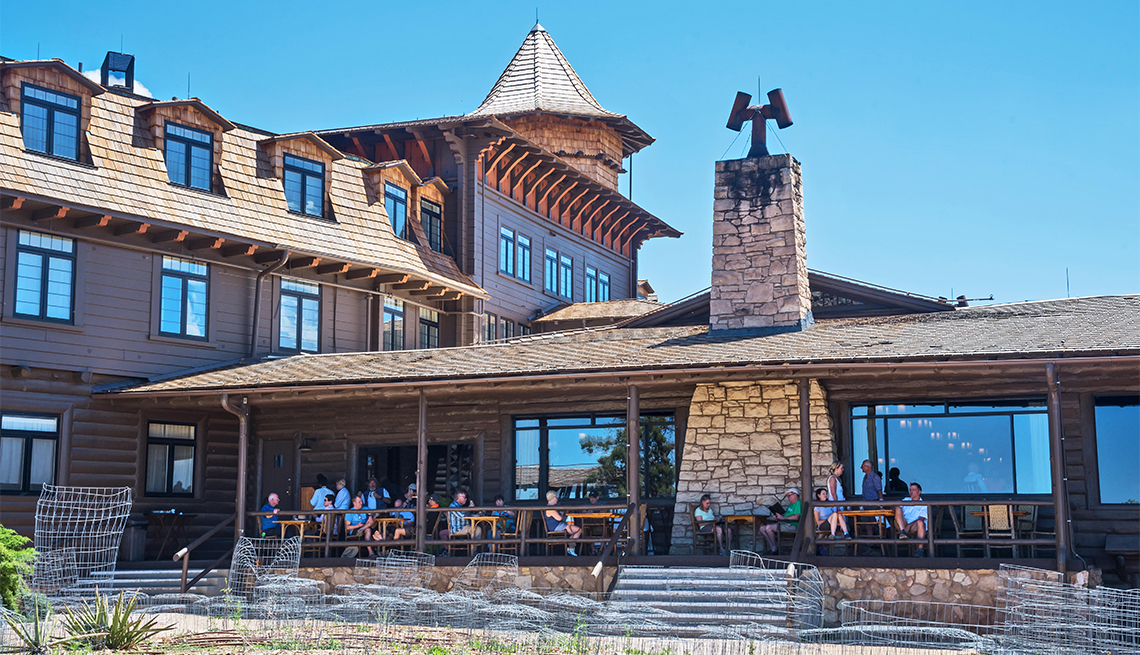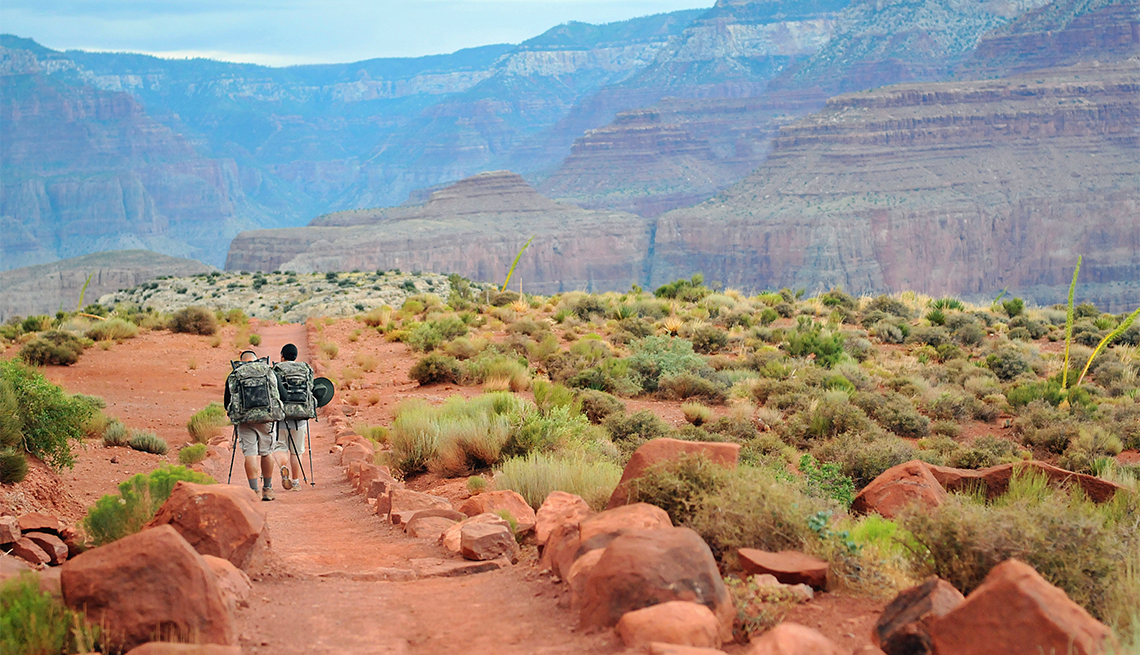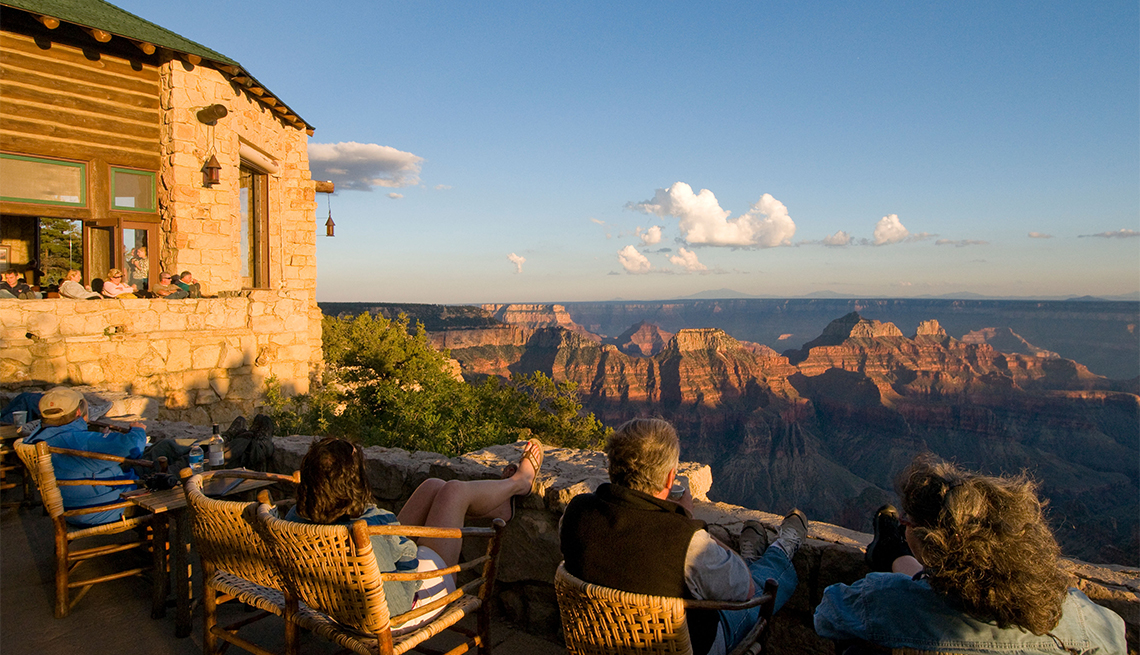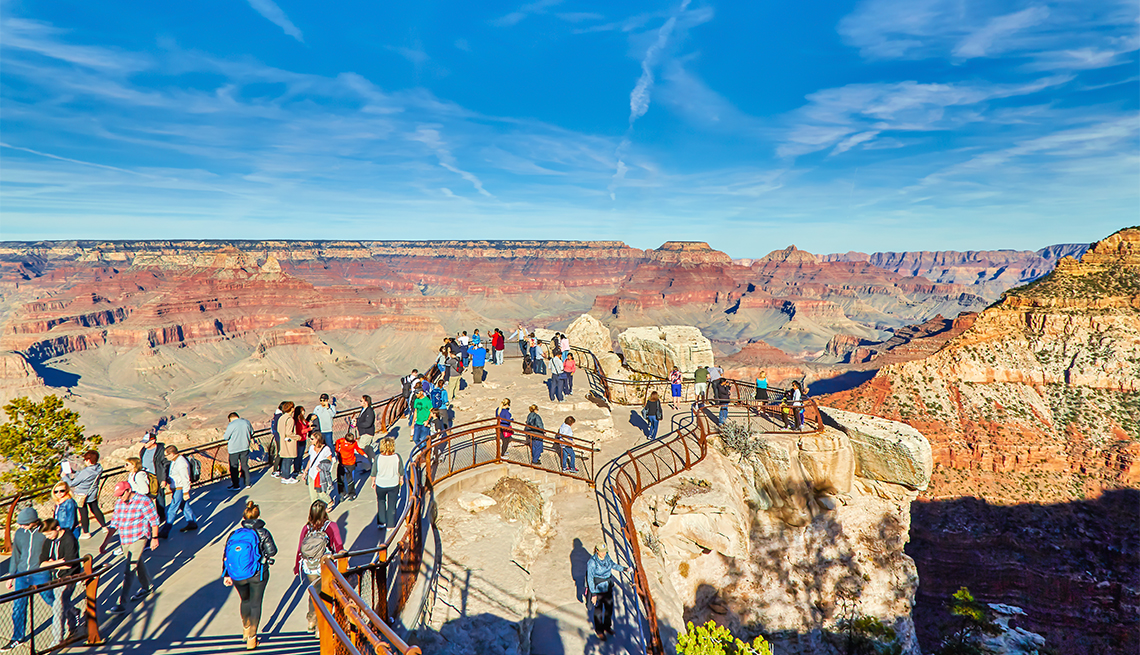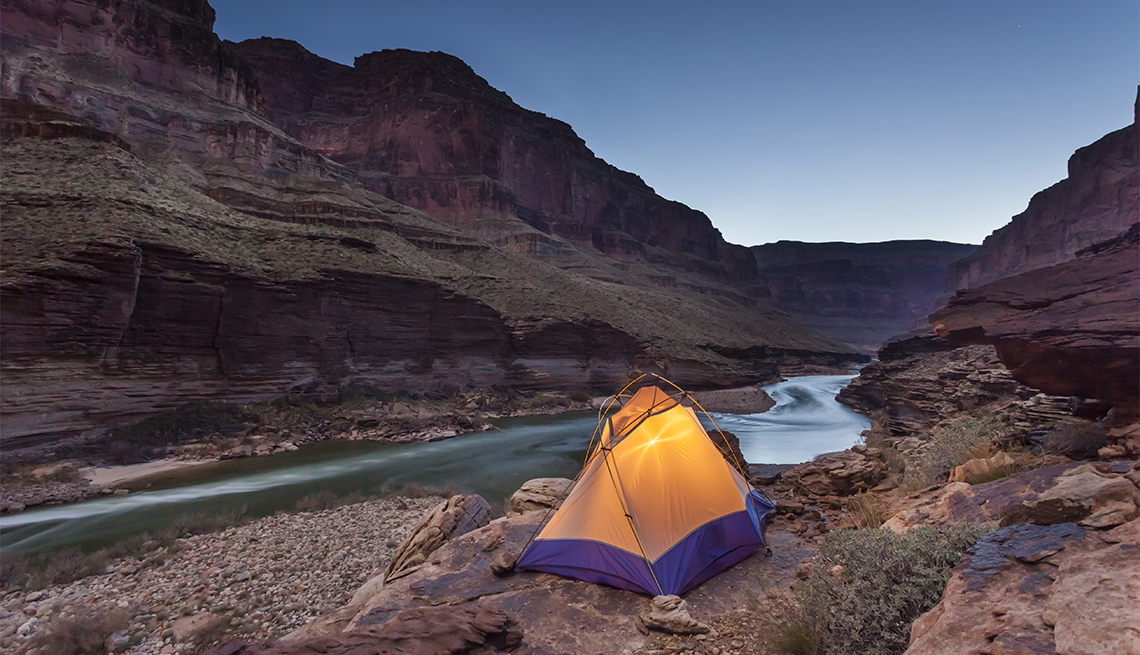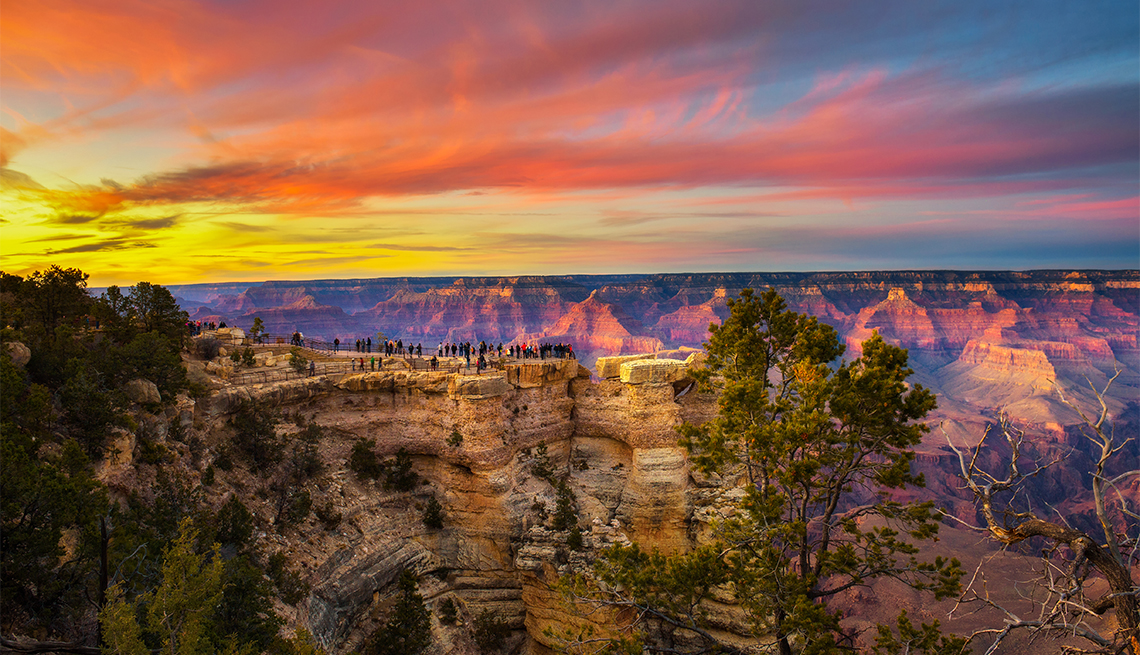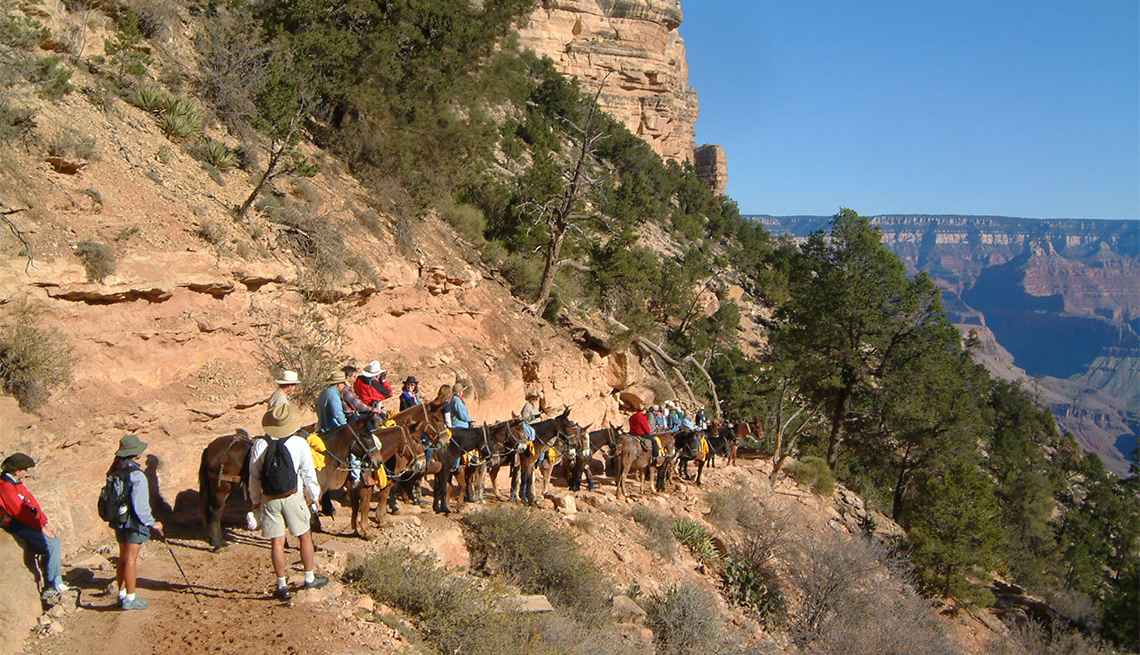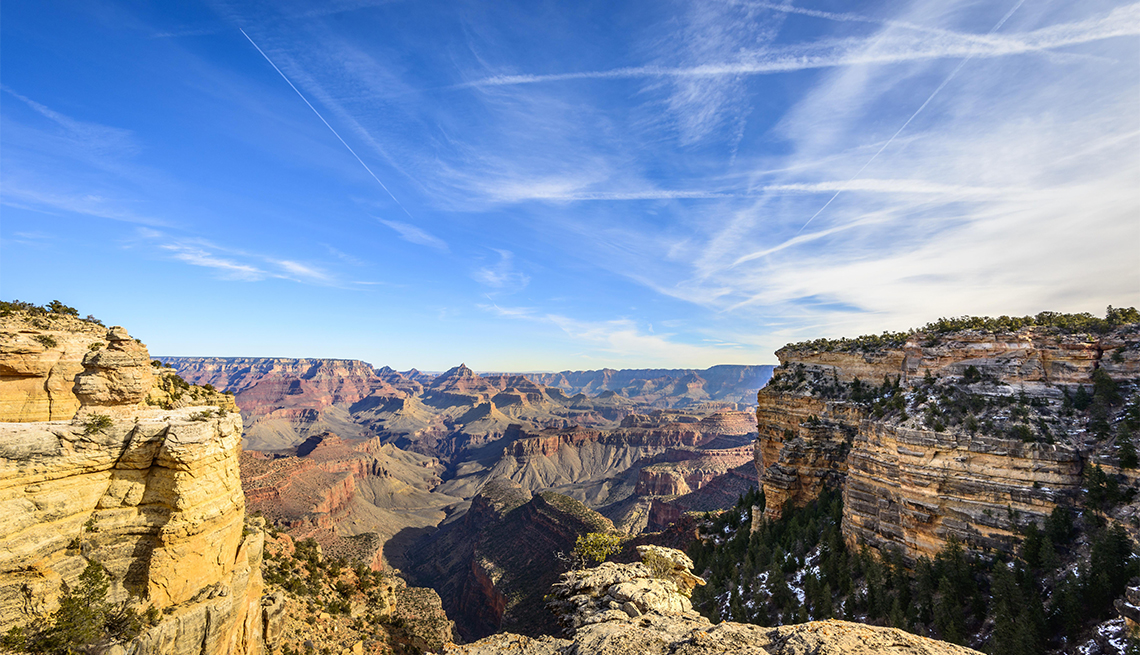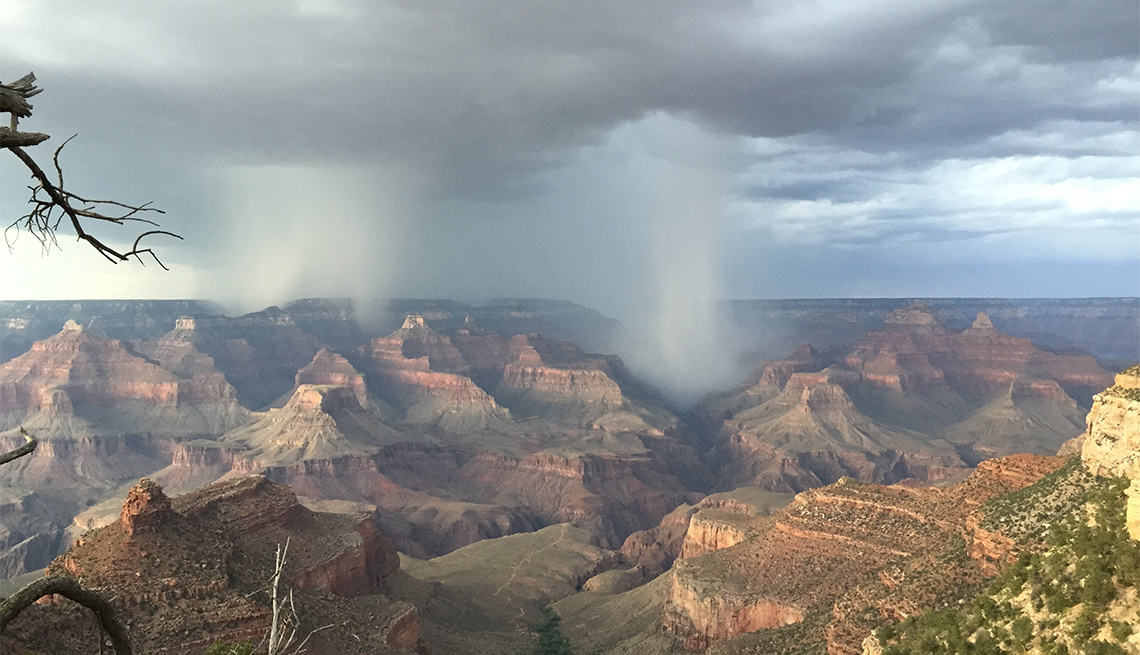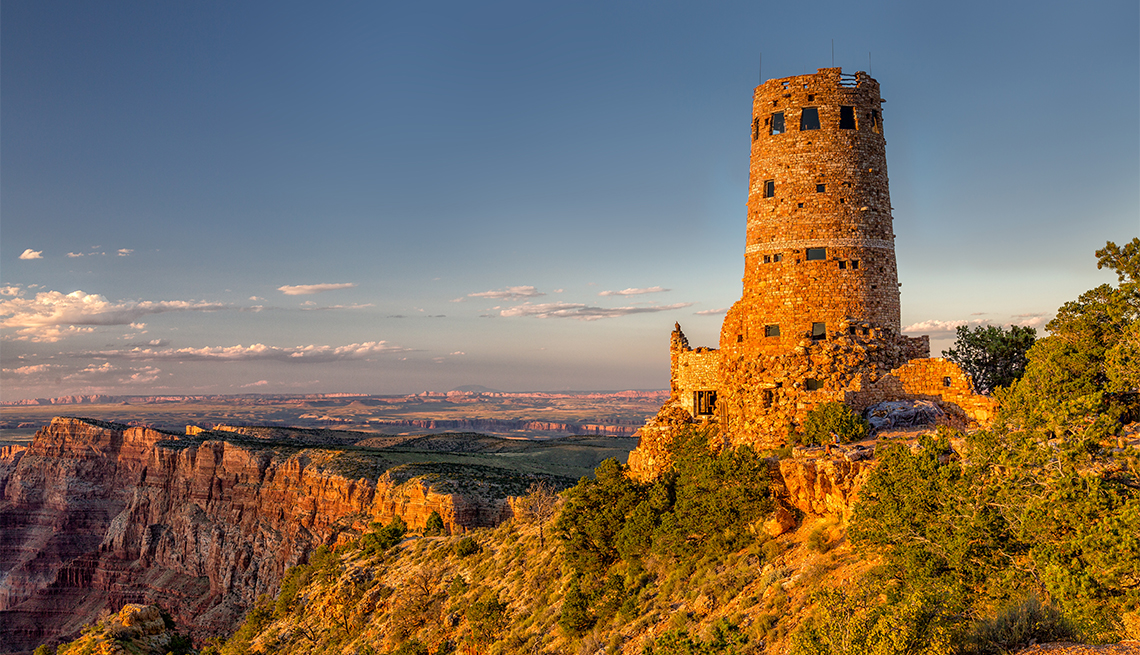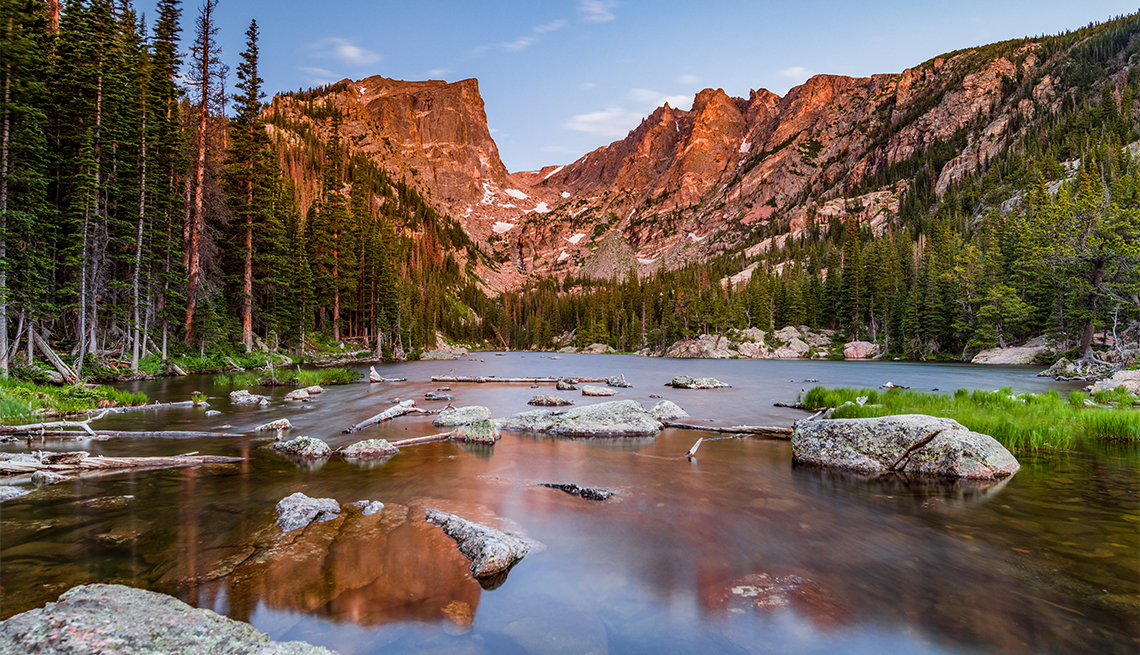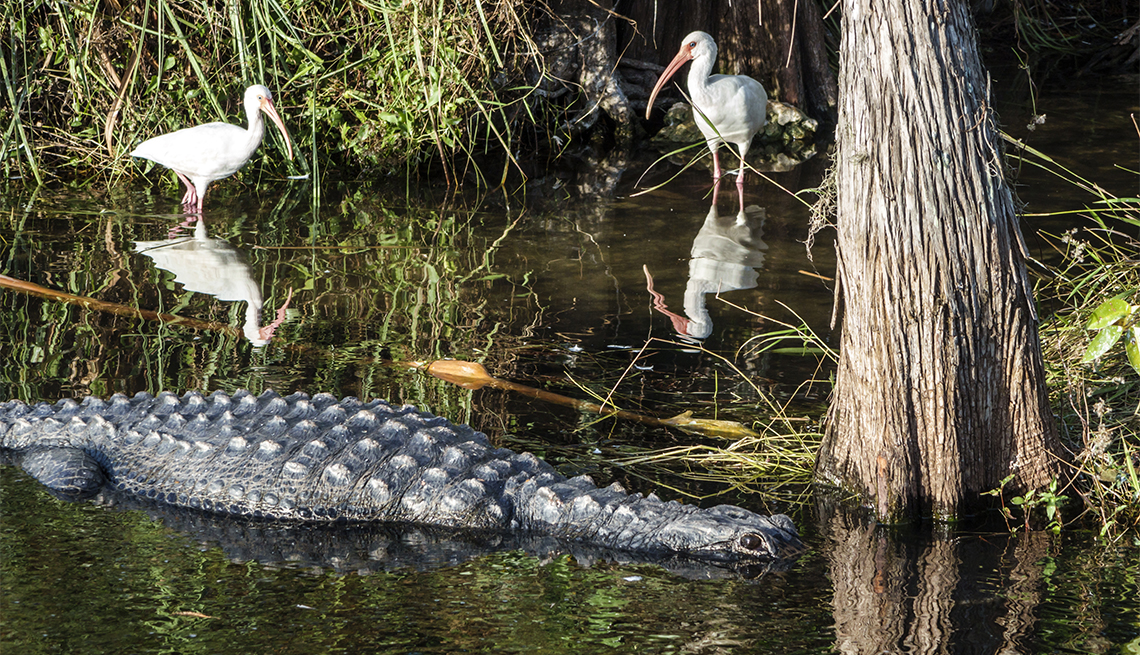AARP's Guide to Grand Canyon National Park
Experience the majesty of the natural wonder — gorges, alcoves, and rocks resembling castles
En español | President Teddy Roosevelt visited the Grand Canyon in 1903, telling applauding crowds at the South Rim that “Arizona has a natural wonder which ... is absolutely unparalleled throughout the rest of the world ... one of the great sights which every American ... should see.” He declared the Grand Canyon a national monument in 1908, with it finally achieving national park status in 1919 after a long political battle with powerful local mining interests.
Nowadays, Grand Canyon National Park (GCNP), with its 1.2 million acres of sweeping landscapes, raging rapids and winding trails, is well on its way to fulfilling Teddy Roosevelt's desire, welcoming more than 6 million visitors annually. And it is indeed a “grand” canyon: Carved from millions of years of the Colorado River's powerful waters, the multicolored layers of eroded rock drop a full mile of elevation from the rim, split by a chasm averaging 10 miles wide, overlooking 277 miles of a river that has challenged rafters since John Wesley Powell's legendary pioneering journey in 1869.
The Grand Canyon's majesty is much more than just facts and figures. This natural wonder has an overwhelming presence that must be experienced in person, as even the best photos and words can hardly do it justice. But naturalist John Muir tried: “I cannot tell the hundredth part of the wonders of its features — the side canyons, gorges, alcoves, cloisters and amphitheaters of vast sweep and depth, carved in its magnificent walls; the throng of great architectural rocks it contains resembling castles, cathedrals, temples and palaces, towered and spired and painted, some of them nearly a mile high, yet beneath one's feet."
Visitors can experience the Grand Canyon's grandeur in ways as varied as the canyon's rocky ridges. From bus tours and easy strolls along the canyon rim, to the famed mule rides or educational ranger programs, helicopter rides flying above it all, and rafting tours in the Colorado River, there's something for everyone.
While GCNP doesn't track visitor statistics by age group, it's revealing that those ages 65 and older represent about half of the guests at the eight lodging facilities in and around the park operated by the Xanterra Collection, according to Hinch Knece, the company's marketing director.
Location: Northwest Arizona, 80 miles north of Flagstaff
Acreage: 1.2 million acres
Highest peaks, lowest valley: North Rim sits at about 8,000 feet, South Rim at 7,000 feet, with the canyon dropping a mile below them
Miles of trails: 35 miles of paved trails and 560 miles of unpaved paths (and 277 miles of river)
Main attraction: Views from atop the canyon, and adventures into it by foot, mule or raft
Entry fee: $35 for cars (Annual Seniors Pass, $20 for visitors 62 and older)
Best way to see it: From scenic rim-top viewpoints at sunrise and sunset
When to go to avoid biggest crowds: September through May
Plan Your Trip
GCNP is located in northern Arizona about 80 miles from both Flagstaff to the southeast and the Utah border to the north, 230 miles from Phoenix to the south, and 275 miles from Las Vegas to the west. You can visit the 277-mile-long canyon from entrances on the North, South, East and West rims, but the South Rim entrance receives about 90 percent of visitors. It also hosts most of the facilities, on-site lodging and activities, and is more easily accessed than the North Rim. The eastern entrance, a lesser-trafficked gate, lies about a 25-mile drive from the South Rim facilities, while Grand Canyon West is a Hualapai tribal development outside of GCNP's boundaries with a glass-bottom scenic skywalk jutting precariously over the canyon cliff, as well as a zipline, rafting excursions, cultural demonstrations, food and lodging.
The North Rim closes November through April, but the rest of the park remains open year round. Admission is $35 per vehicle, good for seven days ($20, Annual Seniors Pass for ages 62 and older). Save time at the gate by buying a digital pass in advance at recreation.gov, or from an outlet in the towns of Tusayan, the South Rim gateway just a mile outside the park, or Williams, 60 miles south.
Summer months and holidays are the park's busiest times. If you visit then, avoid traffic, parking hassles and lines at the South Rim entrance by taking a free shuttle bus from Tusayan, about a 20-minute ride to that gate's South Rim Visitors Center. You can also detour to the East Entrance via AZ 64, and then take a scenic 25-mile-drive along the canyon to reach the South Rim. Or for a particularly fun way to get there, ride the Grand Canyon Railway to the South Rim from Williams in old-time Pullman cars, a journey popular with older adults. Amtrak stops at Williams and farther south at Flagstaff, where it offers shuttle service to the park. Once at the South Rim, hop on ADA-compliant shuttle buses that operate on four routes for easy access to viewpoints, trailheads, lodging and dining (though lines can be long at bus stops in peak seasons).
To avoid the crowds altogether, visit in the slow season from November to February (not holidays), and potentially get treated to a phenomenal snow-covered version of the park. After a fresh snowfall, the canyon looks like an epic orange layer cake with vanilla frosting.
Park weather can surprise visitors, given the rim's altitude of more than 7,000 feet above sea level. The high temperature in midwinter averages in the 40s, with lows in the teens, and regular snowfall. Even in summer, when highs average in the mid-80s and can easily top 100 degrees, mornings and evenings remain chilly, with temperatures dropping precipitously into the 40s. Temperatures at the canyon's base, a mile below, can be more than 30 degrees warmer than at the rim. On any visit, dress in layers, and — given the high and dry environment — stay hydrated.
The South Rim facilities are grouped in three main areas spread over approximately three miles near the canyon. The South Entrance Road winds first past the Visitor Center area, then continues west for a mile to Market Plaza, a practical hub with shops, Park Headquarters, lodging and campgrounds. Another mile west brings you to Grand Canyon Village, the historic center and activity base for visitors, with food, lodging, museums and the train depot. Limited parking is available at each area, with remote lots served by free shuttles.
Cell phone access within the park can be spotty (and nonexistent in the valley), but the Grand Canyon Lodges’ six properties in the park recently upgraded their wireless systems, providing much improved connectivity for guests. You'll find free Wi-Fi at the Park Headquarters, as well as the Canyon Village Market Deli and the Community Library (a half-mile from the train depot).
Where to Stay and Eat
Whatever your taste in lodging — perhaps super deluxe or maybe no frills — GCNP has you covered. But it's important to know that the park's accommodations are typically booked up a year in advance for summer and holiday visits.
The 78-room El Tovar Hotel, built in 1905 and perched proudly like a mountain chalet footsteps from the South Rim's edge, has been called the “Crown Jewel of National Park Lodges.” With moose and elk hunting trophies jutting from vaulted wood ceilings towering over roaring fireplaces, you can imagine Teddy Roosevelt sitting in the lounge trading tall tales with his Rough Rider mates, one of whom built a still extant cabin nearby. You can rent it — the Buckey O'Neill Cabin — at the Bright Angel Lodge, which has 37 basic rooms, many with a shared bathroom, and 53 cabins. Other South Rim options include the 55-room Kachina and 49-room Thunderbird lodges (affordable and contemporary accommodations), and the Maswik Lodge (280 motel rooms).
On the North Rim, Grand Canyon Lodge has 40 basic motel rooms and 179 cabins (nestled in pines) ranging from basic to more deluxe, six with rim views. At the canyon's base, Phantom Ranch is a rustic destination available only via tour operators and a lottery system.
If camping is more your style, you'll have plenty of company. On the South Rim, the 325 sites at the Mather Campground (near Market Plaza facilities, no RV hookups) and the 123 at Trailer Village (about a half-mile from Mather, full RV hookups) are often booked up. Both have laundromats and pay showers, and there are nearby markets. The more rustic Desert View Campground has 50 first-come-first-served campsites for tents and RVs. Sites fill up by noon in high season. The North Rim has a 90-site campground (no RV hookups) with shower facilities and a nearby market. To escape it all, backcountry permits are available. Permit costs vary among the campgrounds, ranging from $6 to $50 per night, with a 50 percent discount for the Seniors Pass. Reservation policies vary, as well.
South Rim food options are plentiful. Bite into the filet mignon with jalapeno chimichurri sauce at the classically elegant El Tovar Dining Room. Stop by for a prickly pear margarita even if you're not dining there. For more casual fare, try Fred Harvey Burger at the Bright Angel Lodge, serving family-friendly fare (with king-size ice cream scoops for dessert); and the Maswik Food Court, next to Maswik Lodge, satisfying appetites with cafeteria food and pizza. Food trucks rove around cooking up tasty tacos and more. For picnic lunches or to stock up for camping, head to the Canyon Village Market & Deli in the Market Plaza area near the campgrounds.
Things to Do
Staring and marveling at the Grand Canyon is the obvious thing to do, but so many other activities available will help enhance your visit. Maybe you can't do all five of these well-worth-it ones highlighted here, but doing at least some should ensure you'll long remember your time at this spellbinding natural wonder. Note: An accessibility guide helps those with impaired mobility or vision decide the best options for them.
Explore 1.8 billion years of history: Sure, the canyon looks pretty, but how in the world did it get here? The park becomes so much more than a scenic hole in the ground when you learn about the area's natural and human history. Joining a free ranger-led tour from the park's three visitors centers is a great way to get started. “Seniors and families have really liked the geology talks and the critter chats,” says Joelle Baird, park information officer. A self-guided walk along the Trail of Time (see below) reveals 1.8 billion years of geologic change in the canyon, culminating in displays at the Yavapai Geology Museum at the trail's east end. Also learn about the people who have made the park what it is. Grand Canyon Village tells the story of native tribes at the Hopi House, of pioneering photographers at Kolb Studio, and the naturalists and explorers at Verkamp's Visitor Center.
Go for a hike: Whether you want a casual stroll to a viewpoint or a heart-pounding climb into the canyon, the variety of GCNP's 35 miles of paved trails and 560 miles of unpaved paths ensures you'll find what's just right for you. While the treks into the canyon can be extreme, “you don't need to go below the rim to appreciate the park,” says Baird. While she sees “a large number of seniors go into the canyon” on shorter hikes, she stresses it's still important “to know your limits, especially with the heat and elevation” at the park.
The most easily accessible and popular hike is the paved Rim Trail, a 13-mile path along the canyon from the Hermit's Rest viewpoint west of the Village to Yaki Point to the east, with many scenic overlooks and photo-worthy stops. Insider tip: To provide human scale within a photo, walk a bit outside the Village, then snap a shot back at people gathered at the overlooks there.
Within the Rim Trail, the Trail of Time segment is the most worthwhile, combining awe-inspiring views with interpretive signage detailing the canyon's history. The 2.8-mile route lies between the Yavapai Geology Museum and Verkamp's Visitor Center, with benches for resting, occasional shady spots and rock displays from the 1.8 billion years of geologic history.
For something a little more adventurous, but still relatively moderate, take a guided 1.8-mile round-trip walk down and back up the South Kaibab Trail, leaving from Verkamp's. The turnaround spot at “Ooh Aah Point” delivers stunning 360-degree views of the canyon depths and up to the rim.
Follow the sun: Come to the park early or stay late for bucket-list worthy sunrises and sunsets. The changing light reveals colors and contours not visible under the blazing midday sun, almost like you're visiting three different parks in one as the day changes. See the shadows play behind towering rock spires as the sun dips to the horizon, bright reds and oranges dimming to soft hues like a movie fading to a close. At sunrise, nature's theater curtain opens with hints of light gradually revealing the majesty below.
The South Rim's popular viewpoints can get crowded, particularly near the South Rim Visitor Center at Mather Point (sunrise) and at Hopi Point (sunset), so stroll along the Rim Trail to a quieter spot — even if it isn't the “ultimate” overlook, it's still going to be pretty darn good. Along Desert View Drive, Pima and Lipan points are less crowded for catching the sunset; try Yaki Point for sunrise. Or tap into local savvy with a Grand Canyon Lodges’ sunset or sunrise bus tour; in-the-know tour leaders take you to the best spots that particular day given the conditions.
Hop on a mule: While fun, riding a sure-footed mule to the canyon floor, a longtime park tradition, may sound a bit too grueling and nerve-racking for you. If so, enjoy a similar experience, minus any angst, with an easy and relaxing mule ride along the South Rim — two hours in the saddle with frequent stops for talks with the rangers. Riders are shuttled from Grand Canyon Village to a corral, where wranglers help with riding instructions. At the North Rim, Grand Canyon Lodge offers slow-paced, one-hour and half-day rides with shuttles from the lodge.
Watch the stars: The Grand Canyon has been designated a “Dark Sky” location due to its prime viewing conditions — high elevation, dry atmosphere and limits on artificial light. The dazzling display, including a Milky Way so bright and close you feel you can touch it, makes the Grand Canyon seem small. Yes, small. The less-developed, darker North Rim draws stargazers year round, but even at the South Rim, Yavapai Point provides an easily accessible spot to set up a telescope or just gaze upward. Or park along Desert View Drive at Lipan Point for excellent gazing.
Gateway Towns
In the small town of Tusayan (population: 587), the South Rim's gateway, be sure to visit the privately run Grand Canyon Visitor Center for a good orientation to the park — it has an information center, tour-operator section and a popular IMAX theater that showcases the Grand Canyon on a six-story screen. The town's half-dozen lodging options range from the budget 7 Mile Lodge to the upscale Grand Canyon Lodge. Dine at the Big E Steakhouse and Wagon Wheel Saloon for some Old West-style ambience and hearty burgers, ribs and steaks.
The North Rim doesn't have any gateway cities of note, but is served by a one-stop shop: The family owned and operated Jacob Lake Inn, 42 miles north the park entrance, offers a hotel, motel and cabins along with dining and a gift shop. Jacob Lake is also a good jumping off point for excursions to southern Utah's national parks, such as Bryce and Zion.
The park's eastern entrance, near the village of Cameron, has a couple of small souvenir shops, diners and Cameron Trading Post, with a motel, RV park, gift shop, gallery and restaurant. It's nearby the little-known but worth-visiting Grand Falls waterfalls, over 181 feet tall and aka “The Chocolate Niagara” for its sometime muddy waters. Nearby, you can go flat-water rafting.
AARP Membership -Join AARP for just $12 for your first year when you enroll in automatic renewal
Join today and save 25% off the standard annual rate. Get instant access to discounts, programs, services, and the information you need to benefit every area of your life.
En Route
Williams, 60 miles south of the park, has a downtown full of charming Route 66 kitsch, with a dozen gift shops, a few friendly diners, cowboy street performances and the Grand Canyon Railway depot. While there, try the delicious burritos at El Corral 66 or the family-friendly pub grub (and tasty microbrews) at the Historic Barrel and Bottle House. Williams is also a base for area activities such as fishing, golfing and hiking.
Flagstaff is a destination in itself, a high desert retreat particularly popular with Phoenix residents who drive the 80 miles north (and nearly 6,000 feet uphill) to escape the summer heat. Three top things to do around the area: Visit the Lowell Observatory (the place where Pluto was discovered) and its science center; go to the Arizona Snowbowl ski resort for summer hikes as well as downhill skiing in winter (yes, in Arizona); and tour the Bearizona wildlife park for its cute bear cubs and other wildlife. Dining and shopping options pack Flagstaff's downtown, and there's plentiful lodging in and around town.
Do make a side trip to Meteor Crater National Landmark, 45 miles east of Flagstaff, even if you think you'll get your fill of canyons at the national park. The mile-wide, 550-foot-deep impact crater is an impressive cosmic contrast to the Grand Canyon's gently eroded landscape. Take time to stop at the visitors center for fascinating science exhibits and films.
- |
- Photos
Editor's note: This article was originally published on July 24, 2020. It's been updated to reflect recent COVID-19 developments.

